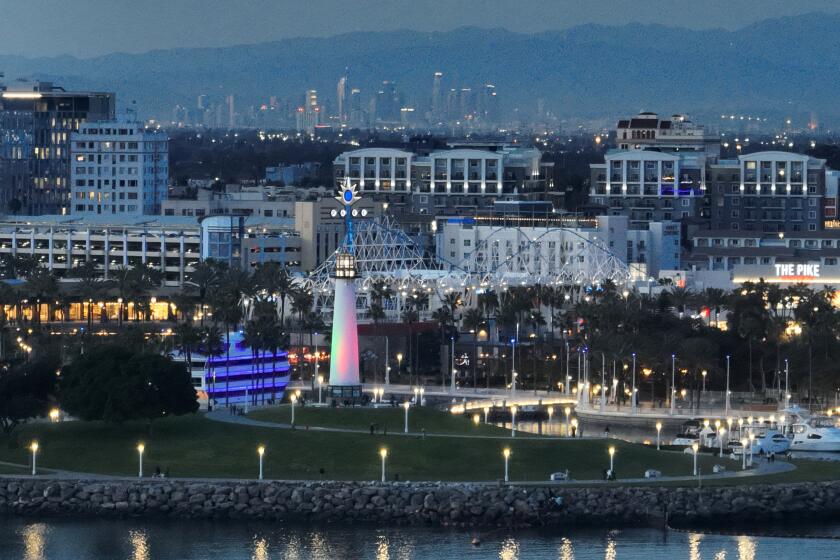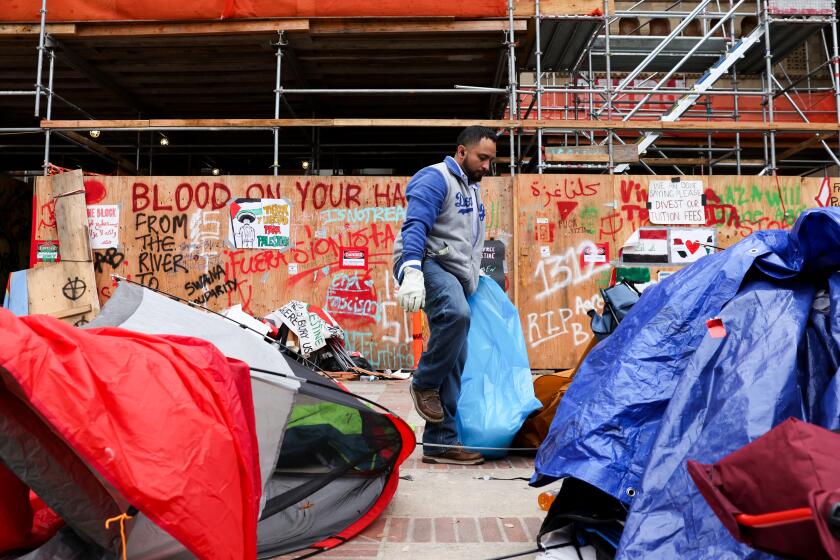In the eye of the firestorm
At 9 a.m. Thursday, three men met on the ridge and studied the mountainside above their homes.
The worst looked to be over. White smoke rose in listless little spirals from blackened earth. The air was still. The mourning doves did their usual dirge from the overhead lines. Sprinklers swish-swished.
But Santa Barbara’s endemic twist on the Santa Ana -- the “sundowner” wind -- is as cagey as it is ferocious.
The winds rush out of the canyons without warning, often around sundown (but not predictably so). They can turn cool days into sweltering nights and, when there’s a fire, drive it straight out of the mountains and to the city’s northern edge.
And then before dawn, they retreat. The fire wanders back into the hills, like some nocturnal predator. Morning breaks peacefully -- and the restless waiting begins.
“I guarantee you this afternoon there will be a full wind event pouring out of this canyon,” said Jack Franklin, a Santa Barbara firefighter who stayed in his evacuated neighborhood to protect his home. “This isn’t over yet.”
Franklin’s wife and daughter had left. He and his 14-year-old son hunkered down Wednesday night as the firestorm with winds of more than 50 mph burned about a dozen nearby homes to the ground. When the sun rose, the sky was clear, with a panoramic view of the ocean all the way to Santa Rosa Island. Franklin left his son to sleep, checked on his father down the road and walked up Ben Lomond Drive to the ridge to chat with a couple of neighbors, Ken Jones and Jim White.
“I spent half my morning trying to rein my dad in,” he quipped. “He’s 72 in shorts and T-shirt, trying to wet down his house.”
They looked out across the vast smoky amphitheater rising to La Cumbre Peak, nearly 4,000 feet high.
Two hawks rode up on a thermal and hovered above the charred ground. “They’re looking for barbecued rats,” said White, 46.
The fire was high in the pines, miles away for now, as if it were no longer a concern.
If this disaster were a hurricane, this moment would the storm’s eye -- a strange slice of outward calm suffused with a blasted heat and the anxiety of what’s to come.
Everyone is stuck in place psychically, if not physically. The evacuees can’t get back into their neighborhoods to see if their homes have survived. The ones who stayed can’t leave, because the sheriff’s deputies won’t let them back in.
On his cellphone, Jones, 47, a plumber, explained a tricky job to one of his workers as choppers roared overhead. “The clean-out is going to be away from the building,” he told him. “Sorry I got stuck up here.”
Firefighters used the calm to crisscross the hillsides dousing hot spots. As many as 16 aircraft circled, dropping water and retardant. On State Street downtown, residents went about their shopping and eating and stood in the crosswalks to get good views of the battle.
Nerves were tuned to the wind. When’s it coming? Forecasters predicted a repeat of the day before. But when?
Michael Glazer, 34, a chef, slipped on his flip-flops and rode his beach cruiser up to Calle Noguera to see what the atmosphere was up to. The state flag at Peabody Charter Elementary drooped languidly in the heat. And the smoke in the mountains hung in place, a white pall.
Glazer edged back and forth on his bike. He said he was surprised by the fury of the fire the day before. He was surprised at how scared he was.
“I’m sure it’s going to be a repeat of yesterday,” he said, keeping his eye on the ridge.
Brent Batchelor, 37, couldn’t take the wait anymore. He had to see his house up Tunnel Road. The digital artist and writer parked his car and started huffing up the hill in the midday heat. He caught a ride halfway up. He said he felt a connection to his property and had an intuition that it survived.
But as he ascended, the landscape got blacker.
“Oh, no,” he said, catching a glimpse of the corner of his property and a scorched eucalyptus. “It got my house.”
He started to panic, but then he saw the thick, whitewashed adobe walls of the garage. He jumped out of the car into a courtyard. The fire had roared right up to the perimeter. But the meticulously kept Mission-era revival home had survived.
There was no mystery how. Its saviors, Ventura city firefighters, left a handwritten note on the front door, addressed to the “homeowner.”
“On 5/6/09 at approximately 4:15 p.m., a firestorm moved through Mission Canyon. During the firefight, a fire engine accidentally scraped the stucco on one of your wooden gate pillars, causing some damage.” The note left contact information and continued: “We apologize for any damage caused.”
Batchelor walked over to the pillar, found a couple of small chips and laughed.
He could barely contain his emotion.
He loved this perch, tucked in the oaks, looking down on the city and ocean. Gazing at all the activity below heightened the feeling of remove. “This is such a precious place,” he said.
Batchelor headed up the hill to check on the house of his neighbors, Bob and Gail, and came across a firefighter, Nicholas Meigs, looking for smoldering spots.
“Thank you so much for saving my home,” he said. “Thank you. Thank you. Thank you.”
Meigs, of the Stanislaus County Fire Department, had wandered up the bare hillsides looking for spots where the fire might be burning below the surface -- “skunking,” in fire jargon -- in the layer of wood-leaf debris firefighters call “duff.”
“If it stays hot like this, it’ll just keep skunking around waiting for the wind to pick it up again,” he said.
He and his crews were digging it up where they could and watching the clouds to see what the wind was up to.
While Batchelor got a lift back to town, Franklin trudged back up to the house on Ben Lomond Drive around 4 to see the same thing.
The mountain kept spouting smoke like a snoring dragon. A gust rattled the leaves and dust devils swirled on the next ridge.
“This is exactly how it started yesterday,” he said.
But the air settled down again.
At least for now.
--
More to Read
Start your day right
Sign up for Essential California for news, features and recommendations from the L.A. Times and beyond in your inbox six days a week.
You may occasionally receive promotional content from the Los Angeles Times.







